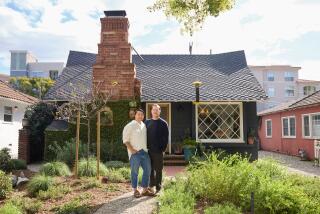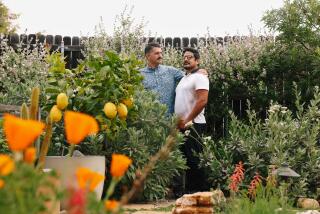Those Odd Plants That Don’t Need Soil : Company Hopes Bromeliads Take Root
- Share via
Bromeliads are hardy plants; some species don’t even need soil.
But they are native to humid climates, so it’s a bit surprising that one of the largest collections of bromeliads in the world is in Gardena, where partners Paul Isley and Jerry Robinson claim to have 500 species on a two-acre spread.
A Santa Monica native who now lives in Manhattan Beach, the brown-haired Isley, 39, retains the look of a youthful surfer. In fact, he uses a skateboard to zip around his bromeliad farm, Rainforest Flora, on Rosecrans Avenue.
“It’s just easier for me to get around this way,” he said the other day as he checked up on his leafy friends, many of them housed in a spacious greenhouse that features waterfalls, a koi pond and two Moluccan cockatoos.
Most people are familiar with one type of bromeliad--the pineapple. Spanish moss, which hangs from trees in the South, is another well-known form. But Isley predicts that vastly dissimilar plants--some with orchid-like blooms, others with gracefully curling tendrils or skirts of feathery spikes--will continue to gain in popularity.
In fact, he confesses to “foaming at the mouth” with excitement over a variety of bromeliad called “tillandsias” or air plants--so named because they grow without benefit of soil and are usually mounted on wood. He has written a booklet entitled “Genus Tillandsia” and says he will soon publish a second, more comprehensive book on “The Tillies,” as he affectionately calls them.
In it, he will describe some of the adventures he and partner Robinson have had while acquiring their plants. Last year, for example, they climbed the steep foothills of the Andes in northwestern Argentina to find a species restricted to cliffs. Isley’s narration will be accompanied by color photographs.
“I want to seduce people into digging deeper and learning more about the tillandsias--so the anecdotes and pictures are there, and I hope that will gradually pull them into more technical stuff, because you need that in order to have a better understanding and appreciation for the plants.”
Most bromeliads, for example, grow in soil, but many species don’t need any. Some can subsist on small amounts of decaying organic material trapped between tree branches. Although some species draw in moisture from roots, most use their leaves to catch and hold rainwater.
Bromeliads propagate by sending off shoots from the base of the plant that can be broken off and planted separately.
Isley’s relationship with bromeliads began with a casual introduction 20 years ago.
“Mark Dimmitt, who is now curator of plants at the Arizona Sonora Desert Museum, showed me all these strange-looking plants that didn’t need soil, and I just couldn’t believe it.”
Isley started propagating the plants Dimmitt gave him and sold them at swap meets, stores and arts-and-crafts fairs. His business partnership evolved out of a chance encounter with Robinson 16 years ago, when they were on separate diving expeditions for sunken ships off Honduras. They recognized each other from their student days at UCLA. Robinson, who lives in Lawndale, merged his marketing background with Isley’s passion for bromeliads to form Rainforest Flora.
Isley’s business sells mostly to nurseries and chain stores, but he continues to exhibit and sell bromeliads each year at the Los Angeles County Fair. He said his customers, who pay from $1 to $150 for the plants, come from as far away as San Diego, Riverside and Santa Barbara.
“One of the big thrills I get is vicarious renewal,” Isley said. “It’s really fun to see people enjoying the plants for the first time. I can relive the excitement of when I was first introduced to them.
“In a completely open atmosphere, like the L.A. County Fair, so many people will just stop dead in their tracks and say, ‘Wow, what are those things?’
“More and more, you see pictures of bromeliads in magazines like ‘House Beautiful’ or ‘Architectural Digest,’ ” he said.
John Provine, grounds superintendent at the Los Angeles County Arboretum, said Isley undoubtedly has one of the world’s largest bromeliad collections. “He’s probably one of the most notable (bromeliad experts) in the Los Angeles area,” Provine said.
Bill Paylen of the South Bay Bromeliad Society said Isley has “a very extensive collection--the biggest in Southern California.”
Danita Rafalovich, a quilt-maker from West Los Angeles who has a degree in botany and is an officer in the National Bromeliad Society, said her interest in the plants was sparked by their “uniqueness.” Many aspects of the biology of bromeliads in general and tillandsias in particular make them unique in the plant world, she said.
If there is a common denominator among bromeliad fanciers, Isley said, it is individuality. “A lot of the people who are into these plants are overachievers or heads of corporations--people who don’t read a magazine to find out what they should look like the next week.”
Although basic care for bromeliads--including the tillandsias, which Isley has mounted on pieces of grape wood--will vary according to their environment, he emphasizes that they need water and bright light.
Yet, even with those requirements, bromeliads make good house plants, Isley said.
“I have them in my yard facing west. When something comes into bloom, I’ll bring them into the house and they’re great for one to three months. Once you have a dozen or so, there’s always something flowering, so you can rotate them.”
What is his favorite kind of bromeliad?
In response, Isley described a recent radio show that asked men what they found sexually attractive in a woman.
“My answer would have been: whatever attribute that’s really nice on that particular woman. And it’s the same with the plants. Whatever tillandsia I’m looking at that’s blooming and amazing . . . that would be my favorite.”






